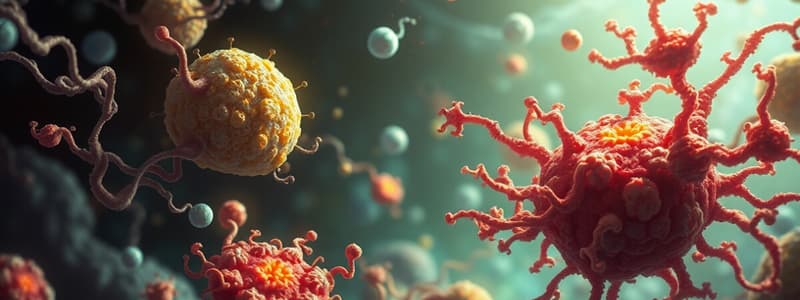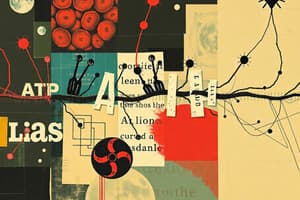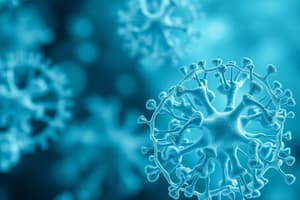Podcast
Questions and Answers
What is the primary function of metabolism in microorganisms?
What is the primary function of metabolism in microorganisms?
- To adapt to extreme environmental conditions
- To synthesize antibiotics for defense
- To exchange genetic material with other microbes
- To reproduce the organism (correct)
Which of the following is characteristic of catabolic pathways?
Which of the following is characteristic of catabolic pathways?
- They are exergonic and release energy. (correct)
- They synthesize large molecules from smaller ones.
- They are endergonic and consume energy.
- They operate independently of enzymes.
How do enzymes participate in catabolic reactions?
How do enzymes participate in catabolic reactions?
- By extracting energy from complex organic molecules and forming simpler end products. (correct)
- By synthesizing precursors for complex molecules directly from simpler products.
- By consuming energy to build complex molecules from simpler components.
- By utilizing energy from catabolism to synthesize macromolecules.
What role do enzymes play in anabolic pathways?
What role do enzymes play in anabolic pathways?
What is the primary function of enzymes in biochemical reactions?
What is the primary function of enzymes in biochemical reactions?
What structural feature enables an enzyme to have specificity for its substrate?
What structural feature enables an enzyme to have specificity for its substrate?
Why is the 'lock-and-key' model used when describing enzyme-substrate interactions?
Why is the 'lock-and-key' model used when describing enzyme-substrate interactions?
How do coenzymes assist in enzyme function?
How do coenzymes assist in enzyme function?
What is the key difference between exoenzymes and endoenzymes regarding their activity?
What is the key difference between exoenzymes and endoenzymes regarding their activity?
How do constitutive enzymes differ from regulated enzymes?
How do constitutive enzymes differ from regulated enzymes?
In metabolic reactions, what is the role of condensation?
In metabolic reactions, what is the role of condensation?
What is the primary purpose of transfer reactions in metabolism?
What is the primary purpose of transfer reactions in metabolism?
How do metabolic pathways directly control enzyme activity?
How do metabolic pathways directly control enzyme activity?
In genetic control of enzyme synthesis, how does repression affect metabolic reactions?
In genetic control of enzyme synthesis, how does repression affect metabolic reactions?
Which statement accurately describes regarding cofactors and their role in enzyme characteristics?
Which statement accurately describes regarding cofactors and their role in enzyme characteristics?
What is the role of exergonic reactions in cell energetics?
What is the role of exergonic reactions in cell energetics?
In a redox reaction, what role do electron carriers play?
In a redox reaction, what role do electron carriers play?
Why is ATP considered a temporary energy repository in cells?
Why is ATP considered a temporary energy repository in cells?
What is the role of NADH in metabolism as an electron carrier?
What is the role of NADH in metabolism as an electron carrier?
How does ATP contribute to the catabolism?
How does ATP contribute to the catabolism?
Which of the following is a primary energy source for anabolic reactions?
Which of the following is a primary energy source for anabolic reactions?
What are the end products of glycolysis?
What are the end products of glycolysis?
What role do NADH and FADH2 play in the Tricarboxylic Acid (TCA) Cycle?
What role do NADH and FADH2 play in the Tricarboxylic Acid (TCA) Cycle?
During aerobic respiration, what is the function of oxygen?
During aerobic respiration, what is the function of oxygen?
What occurs during the chemiosmosis process in electron transport?
What occurs during the chemiosmosis process in electron transport?
Where does the electron transport chain take place in eukaryotes and prokaryotes?
Where does the electron transport chain take place in eukaryotes and prokaryotes?
In anaerobic respiration, what compounds can serve as final electron acceptors?
In anaerobic respiration, what compounds can serve as final electron acceptors?
When and why do some cells undergo fermentation rather than cellular respiration?
When and why do some cells undergo fermentation rather than cellular respiration?
What is the primary purpose of fermentation pathways in cells?
What is the primary purpose of fermentation pathways in cells?
How does fermentation provide cells with a constant supply of NAD+?
How does fermentation provide cells with a constant supply of NAD+?
In the context of amphibolic pathways, what is the significance of metabolic intermediates?
In the context of amphibolic pathways, what is the significance of metabolic intermediates?
Under what conditions does gluconeogenesis primarily occur?
Under what conditions does gluconeogenesis primarily occur?
What is the initial step in Beta oxidation?
What is the initial step in Beta oxidation?
What is generally the role of macromolecules in biosynthesis?
What is generally the role of macromolecules in biosynthesis?
Flashcards
Metabolism
Metabolism
Collection of controlled biochemical reactions within a microbe.
Catabolic Pathways
Catabolic Pathways
Metabolic pathways that break down larger molecules into smaller products and release energy.
Anabolic Pathways
Anabolic Pathways
Metabolic pathways that synthesize large molecules from smaller products, requiring energy.
Exergonic
Exergonic
Signup and view all the flashcards
Endergonic
Endergonic
Signup and view all the flashcards
Enzymes
Enzymes
Signup and view all the flashcards
Enzyme Function
Enzyme Function
Signup and view all the flashcards
Active Site
Active Site
Signup and view all the flashcards
Cofactors
Cofactors
Signup and view all the flashcards
Coenzymes
Coenzymes
Signup and view all the flashcards
Exoenzymes
Exoenzymes
Signup and view all the flashcards
Endoenzymes
Endoenzymes
Signup and view all the flashcards
Constitutive enzymes
Constitutive enzymes
Signup and view all the flashcards
Regulated Enzymes
Regulated Enzymes
Signup and view all the flashcards
Condensation Reactions
Condensation Reactions
Signup and view all the flashcards
Hydrolysis Reactions
Hydrolysis Reactions
Signup and view all the flashcards
Transfer Reactions
Transfer Reactions
Signup and view all the flashcards
Genetic control
Genetic control
Signup and view all the flashcards
Redox reaction
Redox reaction
Signup and view all the flashcards
Electron acceptor
Electron acceptor
Signup and view all the flashcards
Electron donor
Electron donor
Signup and view all the flashcards
Adenosine Triphosphate (ATP)
Adenosine Triphosphate (ATP)
Signup and view all the flashcards
Carbohydrate catabolism
Carbohydrate catabolism
Signup and view all the flashcards
Catabolic pathways
Catabolic pathways
Signup and view all the flashcards
Glycolysis
Glycolysis
Signup and view all the flashcards
Tricarboxylic acid cycle
Tricarboxylic acid cycle
Signup and view all the flashcards
Electron transport
Electron transport
Signup and view all the flashcards
Proton Motive Force (PMF)
Proton Motive Force (PMF)
Signup and view all the flashcards
Chemiosmosis
Chemiosmosis
Signup and view all the flashcards
Anaerobic respiration
Anaerobic respiration
Signup and view all the flashcards
Fermentation
Fermentation
Signup and view all the flashcards
Amphibolic
Amphibolic
Signup and view all the flashcards
Gluconeogenesis
Gluconeogenesis
Signup and view all the flashcards
Beta oxidation
Beta oxidation
Signup and view all the flashcards
Amination
Amination
Signup and view all the flashcards
Transamination
Transamination
Signup and view all the flashcards
Deamination
Deamination
Signup and view all the flashcards
Macromolecules
Macromolecules
Signup and view all the flashcards
Study Notes
Chapter 8: Microbial Metabolism
- Microbial Metabolism covers Metabolism, Energy, Pathways, and Biosynthesis.
Metabolism
- Catabolism, anabolism, and the role of enzymes are key components in microbial metabolism.
- Metabolism involves controlled biochemical reactions within a microbe, leading to the reproduction of the organism.
Catabolism and Anabolism
- Catabolism and anabolism are the two major classes of metabolic reactions.
- Catabolic pathways involve the breakdown of larger molecules into smaller products and are exergonic
- Anabolic pathways synthesize large molecules from the products of catabolism and are endergonic.
- Catabolism uses enzymes to break down complex organic molecules to extract energy and form simpler end-products.
- Anabolism uses enzymes to use energy from catabolism to synthesize macromolecules and cell structures from simpler products.
Enzymes
- Enzymes have functions, structures, enzyme-substrate interaction, utilize cofactors, perform actions and undergo regulation
- Enzymes serve as catalysts for chemical reactions and function by lowering the energy of activation.
Enzyme Structure
- Simple enzymes consist of protein alone
- Conjugated enzymes consist of both protein and nonprotein components.
- 3-D features enable specificity through the active site, also named the catalytic site.
- Conjugated enzymes necessitates a metallic cofactor, coenzyme, or both in order for it to act as a catalyst.
- Amino acids comprise specific active sites that arise due to the folding of the protein (enzyme).
Enzyme-Substrate Interactions
- Substrates specifically bind to the active sites on the enzyme, in a "lock-and-key" or induced fit manner.
- Completion of the reaction sees the release of the resultant product, allowing for the reuse of the enzyme
Cofactors in Enzymes
- Cofactors bind to and activate the enzyme.
- Metallic cofactors example include iron, copper, and magnesium.
- Coenzymes are transient carriers that alter a substrate by moving a chemical group, vitamins are an example
Enzyme Actions
- Exoenzymes, active upon release, initially are not active while inside the cell,
- Endoenzymes remain active inside the cell.
- Constitutive enzymes exist in consistent amounts.
- Regulated enzymes, on the other hand, can either be induced or repressed.
Transfer Reactions
- Condensation is forming a glycosidic bond between two glucose molecules to generate maltose requires the removal of a water molecule and energy from ATP and are associated with anabolic reactions.
- Hydrolysis is breaking a peptide bond between two amino acids requires a water molecule that adds an H and OH to the amino acids and are associated with catabolic reactions.
- Transfer reactions involve the transfer of electrons between substrates through oxidation and reduction, done by oxidoreductase.
- Transfer of functional groups from one molecule to another occurs by transferases such as aminotransferases.
Enzyme Regulation
- Regulation occurs through metabolic pathways, direct control and genetic control
- Metabolic pathways are regulated by the enzymes that catalyze the reactions
- The multienzyme systems follow linear, cyclic, branched, divergent, and convergent patterns.
- Direct control includes competitive and oncompetitive inhibition
Genetic Enzyme Control
- Genetic control is achieved by repression and induction
- Repression happens when end products can stop the expression of genes that encode for proteins (enzymes) responsible for metabolic reactions.
- Enzyme characteristics include being composed of protein, acting as organic catalysts, and lowering activation energy.
- Enzymes have unique characteristics (shape, specificity, function), allow for metabolic reactions at a life-compatible speed.
- Enzymes provide an active site for target molecules and closely associate with substrates, can be recycled and are affected by temperature, pH, and regulated by feedback and genetic mechanisms
Energy
- Cell energetics, redox reactions, electron carriers, and adenosine triphosphate (ATP) are crucial.
Cell Energetics
- Cell energetics involve exergonic and endergonic processes.
Redox Reaction
- Redox reactions are reduction and oxidation reactions
- Electron carriers transport electrons and hydrogens, including electron donors and acceptors.
- Energy in the form of ATP is transferred and captured by the phosphate.
Electron Carriers
- Electron carriers include coenzymes like nicotinamide adenine dinucleotide (NAD)
- Respiratory chain carriers such as Cytochromes (protein) are examples of electron carriers.
- Electron carriers, like NAD, receive electrons and hydrogens from the substrate (organic molecule).
Adenosine Triphosphate (ATP)
- ATP has a temporary energy repository, breaking of phosphates bonds will release free energy
- ATP is a three-part molecule with a nitrogenous base, 5-carbon sugar (ribose), and a chain of phosphates.
- The phosphates captures the energy being released and becomes part of the ATP molecule.
- ATP is used to phosphorylate an organic molecule such as glucose during catabolism.
- ATP is synthesized via substrate-level phosphorylation.
Carbohydrate Catabolism
- Numerous organisms catabolize carbohydrates, like glucose, as an energy source
- Carbohydrates undergo oxidation, used in anabolic reactions,.
- Cellular respiration and fermentation are the two processes for glucose catabolism.
Pathways
- Key catabolic pathways: Embden-Meyerhof-Parnas (EMP) pathway or Glycolysis, Tricarboxylic acid cycle (TCA), Respiratory chain (aerobic and anaerobic), Alternate pathways, Fermentation
- Metabolic strategies for heterotrophic microorganisms growing on glucose involves aerobic respiration, anaerobic metabolism, fermentation and respiration
Glycolysis
- Glucose oxidation with intermediates undergoing phosphorylation (using two ATPs)
- Six carbon split into two 3-carbon sugars
- The net production is two ATP and two pyruvic acid molecules, NAD is reduced to NADH, and water is generated.
TCA Cycle
- Every pyruvic acid gets processed to enter the TCA cycle (two complete cycles).
- Critical intermediates are synthesized, coenzymes NAD and FAD get reduced to NADH and FADH2, also CO2 is generated and two ATPs.
Electron Transport
- NADH and FADH2 donates electrons to the electron carriers, membrane bound carriers then transfer the elections using redox reaction
- The final electron acceptor, like oxygen, completes the terminal step
- Electron transport chain uses Mitochondria on eucaryotes, and cytoplasmic membrane of procaryotes
- The process leads to Chemiosmosis and proton motive force (PMF).
Aerobic and Anaerobic Reactions
- Fermentation yields small amounts of partial ATPs
- Aerobic yields 42 - 2 ATP, with aerobic respiration comprising glycolysis, the tricarboxylic acid (TCA) cycle, and electron transport.
- Glycolysis begins the cycle (two ATP’s generated), followed by the TCA cycle and ultimately ending with electron transport.
- Anaerobic respiration similar to aerobic respiration, however using nitrite or nitrate as the final electron acceptor.
Fermentation
- Occurs when cells cannot entirely oxidize the glucose by cellular respiration.
- Fermentation pathways provide constant cells that uses NAD+
- Requires ongoing supplies of NAM+ for partial oxidation of sugar or metabolites.
- NAD+ supplies are dependent on metabolizing large quantities of glucose during fermentation
- Processes rely on final electron acceptor
Types of Fermentation
- Key processes involving glycolysis only
- Occurs when there is final electron acceptor for electron transport needed, which has the final step of using electron transport that completes the terminal step (ex. Oxygen)
- NADH from glycolysis then gets utilized to reduce resultant organic products.
- Organic compounds act as the concluding electron receivers.
- Includes alcoholic, acidic, and mixed acid fermentation with some facultative anaerobic bacteria
- Some are strict fermentation like yeast
Biosynthesis
- Biosynthesis is anabolism, involves amphibolic reactions, gluconeogenesis, beta oxidation, amination, transamination, deamination and requires marcomolecules
Amphibolicism
- Integrates catabolic and anabolic pathways, intermediates serve multiple purposes,
Biosynthesis Reactions
- Amino acids use amination, where pyruvic acids is converted to B-alanine
- During transamination Aspartic acid get conversted to Glutamic acid
- Deamination converts Glutamic acid to a-ketoglutaric acid
- Intermediates serve to synthesize amino acids, carbohydrates and lipids from the reactions of glycolysis, the TCA cycle using simple products like NH3, CO2, H2O
- Gluconeogenesis converts pyruvate into glucose when the glucose supply is limited.
- Beta oxidation is the Metabolism of fats into acetyl can then enter the TCA cycle as acetyl CoA.
Macromolecules
- Cellular building blocks include monosaccharides, amino acids, fatty acids, nitrogen bases, and vitamins.
Studying That Suits You
Use AI to generate personalized quizzes and flashcards to suit your learning preferences.



